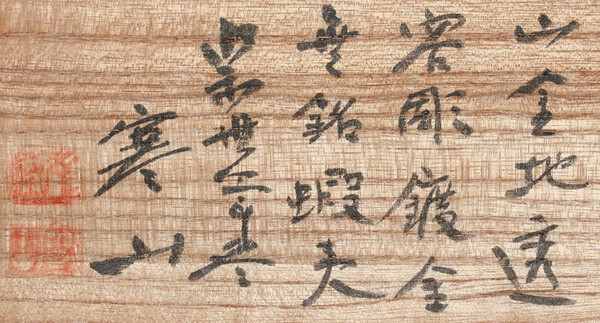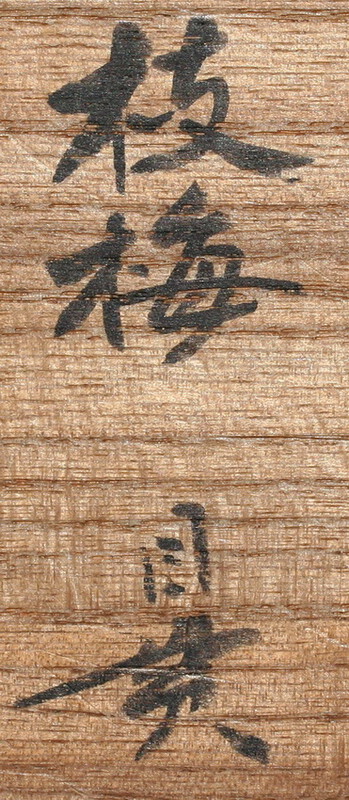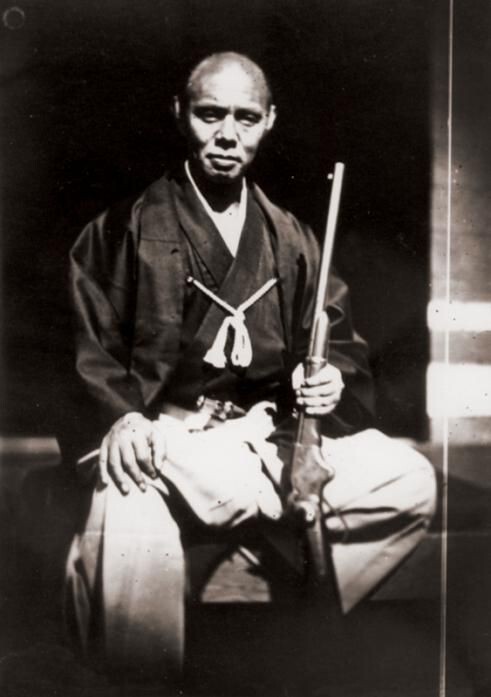-
Posts
2,814 -
Joined
-
Last visited
-
Days Won
27
Content Type
Profiles
Forums
Events
Store
Downloads
Gallery
Everything posted by Bazza
-
Ughhh!!! And it has to be super gaudy because... BaZZa.
-
A mate sent me this link with a very unusual horimono. I have a very slight memory that such a horimono has been discussed in the past. I've never seen anything like it in any book that I recall. At first I was going to call it a "Horrormono", but knowing the Japanese there could indeed be something deeply mystical in this: http://page10.auctions.yahoo.co.jp/jp/a ... m119422206 Bestests, BaZZa.
-
Mark, very nice. Could we please see some pics of the gun?? Some overall shots and some closeups would be great. Bestests, BaZZa.
-

had this old polishing stone for ahwile
Bazza replied to atma-san's topic in General Nihonto Related Discussion
IMHO this is Chinese and not Japanese, and not a polishing stone. It has a look of marble in the fracture and crystalline structure is too coarse for a polishing stone, but what do I know... BaZZa. -
Thank you for comments Jean, Jean C., and John L. As to "What is it?", the other descriptive term in my mind is Heianjo. When Alan Harvie saw this tsuba 40-ish years ago he said "Heianjo, Yoshiro, but which", or words to that effect as I'm remembering them today. I meant to include a mention of Gary Murtha's two volumes on "The Samurai Sword - An American Perspective". In one of the volumes is a near identical tsuba to mine. It is very well photographed with shining, gleaming brass inlay. I think it was the garishness of the shinchu inlay on this tsuba that encouraged me to leave mine as I found it. Sadly as I scan my library shelves I cannot see either volume, so they are probably boxed away to make room for a new crop of books. It is said a polisher's home is crowded out with stones, so mine is crowded out with books... http://www.amazon.com/Samurai-Sword-An- ... 0911311025 Regards, BaZZa.
-
Greetings All, As one who has never made tsuba an intimate study I have read this thread with the greatest of interest and thank all for their passion. I present here for interest an unusual (kawari?) Yoshiro zogan tsuba in less than pristine condition. It is as I got it in antique koshirae long ago, the blade having cracked nearly in half by a goomba who tried to cut a tree with it... In the first NBTHK Shinsa in New York 40-ish years ago this was awarded a Tokubetsu Kicho paper. The paper and translation are buried in my accumulation of stuff, so better show it here and now rather than wait until I've found the detail!!! With apologies to two Board members who are waiting on a reply from a year or more ago. Gomen. In the closeup of the reverse side I'm not sure whether the black bits represent lacquer remnants or simply the rust and gunge of ages. This is partly why I have never "cleaned" it. Any advice on this is welcome and I would appreciate any comments on the tsuba itself. It seems evident that it is not in the same quality range as those previously presented. Best regards, BaZZa.
-

Please Help with Gendaito Mei Translation
Bazza replied to Edward G's topic in Translation Assistance
SHIGENORI KIN SAKU - respectfully made by Shigenori. The date is quite elementary Edward, gambatte kudasai... Bestests, BaZZa. -
Dear Ffolke, I have edited my post above to add a photo of the menuki backs. I did not have it at the time so I've just taken some shots. The colour is truer to the silk than the pic of the fronts. I should also have added that these have a NTHK paper to Ezo, Muromachi/Momoyama (I forget which). I'll post that later when I dig it out. Boris, thank you very much for your comments. I have long admired your posts and your website. Junichi, thanks for the PM prompt re a photo of the backs. Bestests, BaZZa.
-
Gentle Ffolke, I cannot add much to this topic except to show a pair of menuki I have with Kanzan hakogaki. I bought them because I liked them. Having read of fake Kanzan hakogaki I do not know if this is a "kosher" pair. Bestests, BaZZa.
-
Clive, thank you for notifying the membership of Mike and John’s passing and my sincere condolences to their families. I remember well these luminaries of those days and am saddened to hear of their passing. Like George and many others I'm also a geezer from 70s and remember well the high educational value for a wide-eyed newbie of the “Programme”, the newsletter of the To-ken Society of Great Britain. I still have most of the issues and have been “gunner” turn them into PDFs for many years now and I earnestly hope that isn't an ideal thwarted by falling off my perch any time soon!! I think that the internet these days has long since overtaken the knowledge contained in the pages of the “Programme”, but I'm equally sure there are still pearls of wisdom therein. Bon Dale was another very active To-ken member and I think it was he who was the primary organiser of The Ashmolean Museum exhibition. Some of you may have the catalogue, within which a most memorable piece was the three-foot long tanto... Bon and I had some correspondence in those far-off times. With sadness, Barry Thomas.
-
Home made??? i.e., "shinsaku"!!!!! Bestests, BaZZa.
-
Brian's last sentence is a very succinct expression of both the beginning collector's dilemma and indeed the more advanced collector. Peter Bleed asked a question in his "Less than Preservable?" thread viewtopic.php?f=9&t=17745 that bears on this. I was doing some research to see if I could find any backing for an idea that Keith's sword might be a Bungo Takada blade as these smiths mostly signed FUJIWARA XX. I had googled "bungo takada school" and was working my way through the hits when I came across an essay in our Articles section. Anyone who has followed this thread with interest would do well to read it as IMHO it is very germane to the question Peter raised in his thread and is I feel somewhat relevant to the discussion here as well: http://www.nihontomessageboard.com/arti ... chools.pdf I've also posted this in Peter Bleed's thread. A Very Happy Nihonto New Year to all. Bestests, BaZZa.
-
Well, as happenstance would have it I was doing some research on a sword in another thread (Keith McCauley, "new sword", viewtopic.php?f=15&t=17221) when I came across an essay in our Articles section. Anyone who has followed this thread with interest would do well to read it as IMHO it is very germane to the question Peter raised: http://www.nihontomessageboard.com/arti ... chools.pdf I'll also post this in Keith's thread. Can I wish everyone a Very Happy Nihonto New Year. Bestests, BaZZa.
-
An eminently sensible question Peter and one that has always been a dilemma. A polisher I once met (Japanese) was passionate about his art and said "All swords should be preserved". Many years later I showed a wakizashi in dreadful condition to another (Japanese) polisher, equally passionate. I knew the wakizashi wasn't too good the condition notwithstanding, but as it was mumei I was curious about a single kanji on the mune of the nakago. He looked at it and said (without commenting on the kanji) "This is the worst kind of sword you can have". Hmmmmm... Given that a polisher has IMHO the equivalent of a PhD (or two), why would he consent to putting poor art quality, though good and serviceable weapons, on his stones with his hard won years of knowledge??? My collecting path over 50 years has been to buy books and to look at as many swords as possible. Here in Australia without good museums and sensei this meant for me "beating the bushes" to turn up as many swords as I could and decide which were "good" and which "bad" by criteria I divined from The Books. Its never been a good policy to sink a few thousand dollars into polishing a sword just because one "likes it" and ending with something worth half as much or less on the market. So to cut it short, for most Western collectors Peter's question boils down to running the gauntlet of experience and learning by trial and error. It is very time consuming and one has to be passionate. A person's means obviously filters in here too, and in truth and finality there isn't enough money or artisans in the world to preserve all swords, nor collectors to house them decently, never mind the vicissitudes of swords in hands ignorant of their intrinsic qualities or of their cultural and historical significance. Never mind myopic governments.... Bestests, BaZZa.
-
This is terrible news. He was born in the year I started work as a 17 year old. For such a talented man to pass so early at age 53 one can only think the Gods got it wrong!! It spurs me to think that in the unknown time I have left I must strive harder to achieve something worthwhile. Tony's energy and ability left a legacy that few can hope to emulate. My sincerest and deepest condolences to his family, colleagues and friends. Rest in Peace Tony. Barry Thomas.
-
Chris, I'll trade you photos for any information you have about these smiths... sometime!!! I've attached photos of a lovely Tamahide wakizashi that crossed my path five years ago in a lovely koshirae. I'm sorry I have no information as to which generation this one is. Best regards, Barry Thomas (aka BaZZa)
-

7 Amazing Vintage Photos Of 19th-Century Japan
Bazza replied to Bazza's topic in General Nihonto Related Discussion
Thank you indeed Eric. I've just had a good hour trawling those photos and noted many historical figures of the Bakumatsu and Meiji eras. I noticed one photo that would especially appeal to our "gunny" members. I know it did to me because a mate of mine has a Spencer carbine and this type of gun was used by the Gold Escorts here in Victoria, Australia, and was also used by the police who were chasing our notorious 19th century outlaw Ned Kelly. I've attached the photo in question and here is some supporting blurb: The photo is titled "Shima Kakoku "Kawazu Izu no kami", albumen print, 7.8 x 6 cm, ca 1860, coll. Shima Eiichi., shown with Spencer carbine." The photographer is SHIMA KAKOKU http://en.wikipedia.org/wiki/Shima_Kakoku The subject of his photograph is KAWAZU IZU no KAMI, a high-ranking samurai: http://www.bridgemanart.com/en-GB/asset ... umen-print Bestests, BaZZa. -
Dear All, a friend has sent me the following link: http://urbantimes.co/2013/12/Japan-vintage-photography/ that shows "7 Amazing Vintage Photos Of 19th-Century Japan". The introduction reads "This week, the Public Domain Review (PDR) posted a series of hand-colored albumen prints that date back to 19th-century Japan. Albumen is a process that used egg whites to bind the photographic chemicals to the paper. The prints, uploaded by the Dutch National Archieff, offer a glimpse of life in Japan some 150 years ago." At the end there is a comment by the contributor Keiko Tanaka "View more images from the series of 42 hand-coloured albumine prints from Spaarnestad Photo by Felice Beato, Kusakabe Kimbei or Raimund baron von Stillfried." The direct link is: http://www.flickr.com/photos/nationaala ... 774885996/ I was quite surprised to see an old mechanical Japanese typewriter at left in the 7th row down. In the day of the computer these machines are real fossils. I happen to have one with trays of different fonts in one of my sheds. I rescued it from a scrap metal dealer because I couldn't bear to see it destroyed, so it lives with many other "might come in handy one day" items on rows of shelves... I would give it free to a good home... Compliments of the Season to all you good Nihontojin, with grateful thanks for a good year on NMB and looking forward to 2014. Best regards, BaZZa.
-

Kozuka found on ebay was told it was from edo period
Bazza replied to Nihontocollector19's topic in Tosogu
I still have a gilded brass kogatana that fell into my lap decades ago. It was originally fitted into a kozuka and like the OP's item it was very nicely made. I seem to recall the kogatana and kozuka came in an indifferent Meiji period tanto or wakizashi. Bestests, BaZZa. -
I think I get MITSUHIRO something (saku?) for the maker. All at sea on the rhs inscription. Bestests, BaZZa.
-
I'm close to 100% sure that Ron's KAO is the early work of Shodai Yasuchika. I'm tied up at present but I'll look into this further in the next day or two and come back with images of my own, both a piece and a book reference (God, I'm in chaos...). Bestests, BaZZa.
-
Sake barrel scraper???? Bestests, BaZZa.
-
THE TSUBA - THE TSUBA - who knows what about the tsuba??? I nearly fell over when I saw it as I had an almost identical tsuba decades ago also with fukurin. I always wondered about it. I have read of larger pre-Edo tsuba being reduced in size and fitted with a fukurin that gave the design a cramped look. The katakiri dragon with kebori detail was very interesting. Inevitably it had to go to afford something else, but I've never forgotten it. BaZZa. EDIT: Shishi, not dragon...
-
Sekigane, that's what I meant (I learnt in Japanese language study to "follow the discourse..."). Since this has turned into a Namban thread thought I would put up my Namban tsuba again, more especially as it has a beaded rim very similar to mine, whereas mine is covered with gold. Apologies to those who have seen it before, but it might be new grist for many others. The tsuba is 75mm wide x 82mm high x 6mm thick. The front is noticeably convex to the extent of the sides being approx. 2mm lower than the seppa dai. Interestingly, the tsuba back is "flat" without any curvature. It is also not perfectly circular, being more of an oblate spheroid (slightly pear-shaped, no puns please!). John L also noted early 19th century. Mine garnered an NBTHK Green Paper in New York something like 40 years ago. If I remember correctly the attribution at that time was "late 17th century". My memory may be uncertain. Under the gilt plate on the tsuba front is a seppa dai of stylised clouds as per the back side. Bestests, BaZZa.
-
Horse armour???? Bestests, BaZZa.














